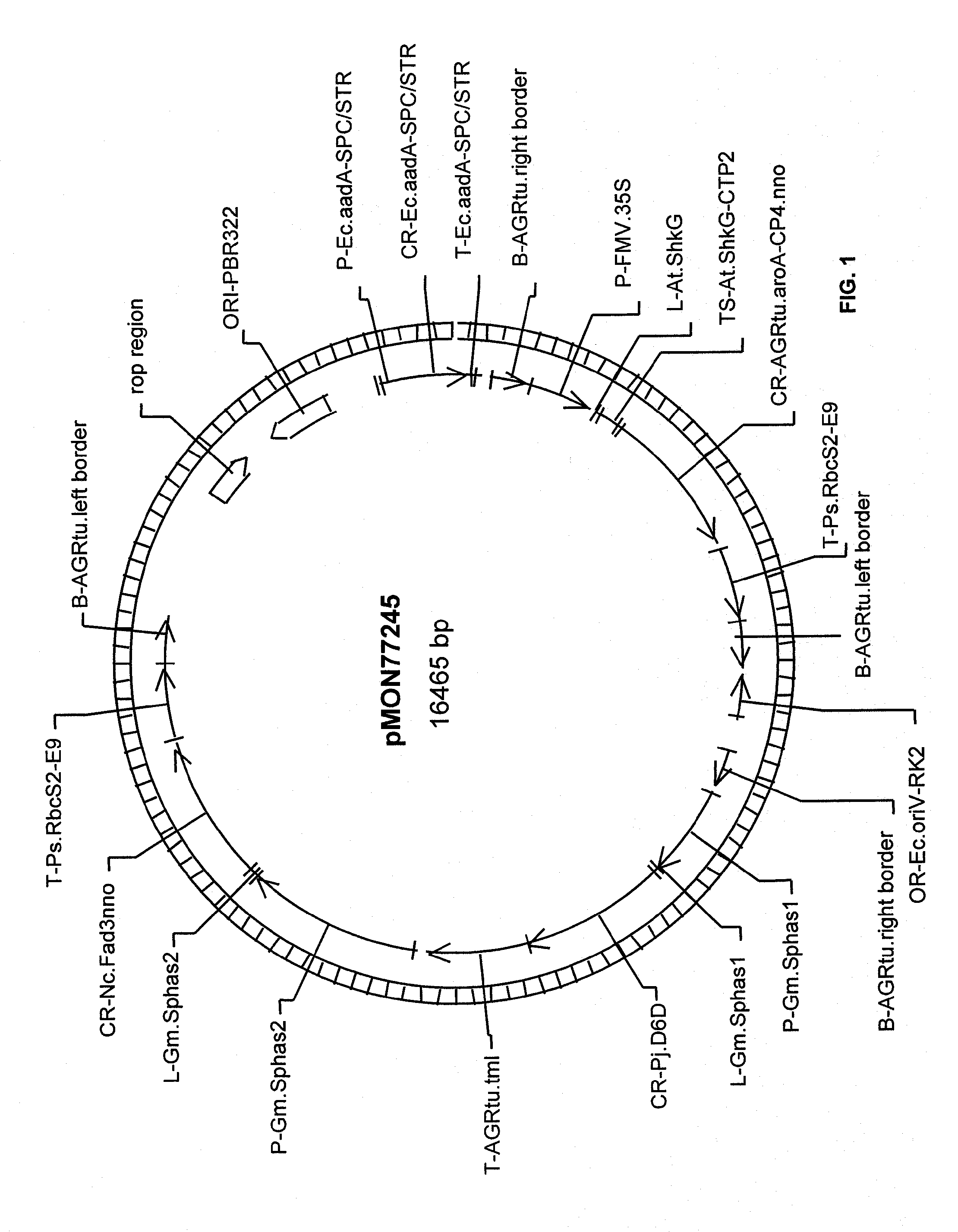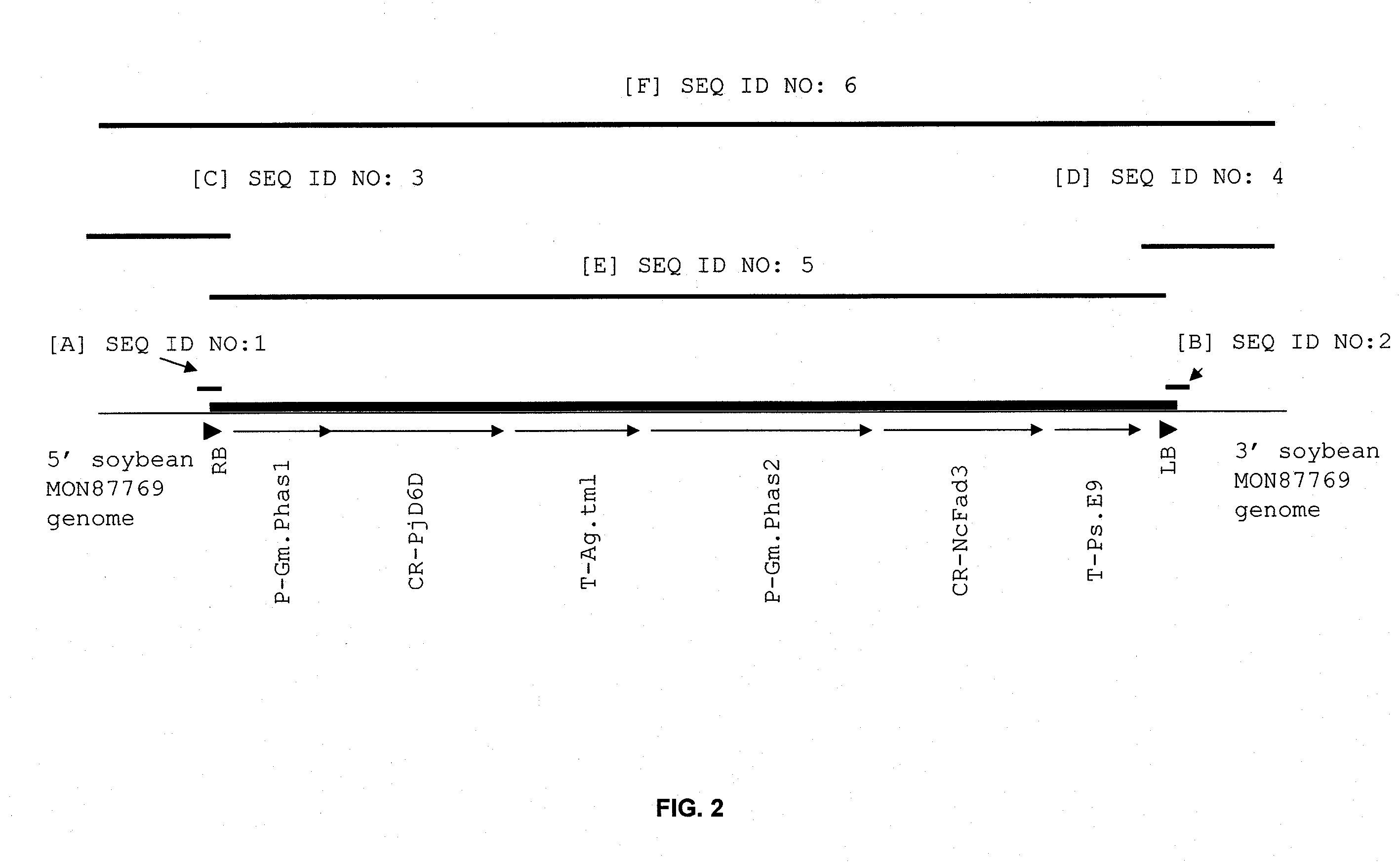Soybean plant and seed corresponding to transgenic event mon87769 and methods for detection thereof
a technology soybean seeds, applied in the field of transgenic soybean plants comprising event mon87769, can solve the problems of uncontrollable fluctuations in availability of natural sources of pufas, fish stocks may undergo natural variation or may be depleted, and fish oil also has unpleasant tastes and odors
- Summary
- Abstract
- Description
- Claims
- Application Information
AI Technical Summary
Benefits of technology
Problems solved by technology
Method used
Image
Examples
example 1
Transformation of Soybean A3525 with pMON77245 and Event Selection
[0065]The initial transgenic soybean plant comprising the event designated as MON87769 was generated by an Agrobacterium-mediated transformation of soybean cells with a DNA fragment derived from pMON77245 (FIG. 1; see U.S. Patent Application Publication No. 20080063691, incorporated by reference). The binary plant transformation vector pMON77245 contains two plant transformation cassettes or T-DNAs. Each cassette is flanked by right border and left border sequences at the 5′ and 3′ ends of the transformation cassette, respectively. An expression cassette (SEQ ID NO: 7) is used for the expression of two desaturase genes. The two-gene cassette is organized as follows: the nopaline right border sequence, followed by the first gene cassette comprised of the promoter and leader sequence from the Glycine max 7S alpha′ subunit of the beta-conglycinin storage protein (alpha′-bcsp) gene, which is upstream of the Primula juliae...
example 2
Isolation of Flanking Sequences Using Inverse PCR
[0068]Sequences flanking the T-DNA insertion in MON87769 were determined using inverse PCR as described in Ochman et al., 1990 (PCR Protocols: A guide to Methods and Applications, Academic Press, Inc.) and by TAIL (Thermal Asymmetric InterLaced) PCR. Plant genomic DNA was isolated from both wild type A3525 and the transgenic line from tissue grown under green house conditions. Frozen leaf tissue was ground by mortar and pestle with liquid nitrogen or mechanical grinding. A volume of 22 mL of extraction buffer was added to ˜1 g of ground leaf tissue and incubated at 65° C. for 1 hour. The CTAB extraction buffer consisted of 1.4M NaCl, 2% CTAB, 20 mM EDTA, and 100 mM Tris-HCl pH 8.0. Just prior to use, 0.02% beta-mercaptoethanol and 0.5 mg RNase A was added to the extraction buffer. The samples were extracted with 12 mL of phenol / chloroform / isoamyl alcohol (25:24:1) solution and then centrifuged at 4000×G for 10 minutes at 4° C. The sup...
example 3
Event-Specific Endpoint TaqMan and Zygosity Assays
[0071]Methods used to identify the presence of event MON87769 in a sample are described in an event-specific endpoint TaqMan PCR assay, for which examples of conditions are described in Table 1 and in Table 2. The DNA primers used in the endpoint assay are primers SQ5923 (SEQ ID NO: 8), SQ5924 (SEQ ID NO: 9) and 6FAM™ labeled primer PB2511 (SEQ ID NO: 10). 6FAM™ is a fluorescent dye product of Applied Biosystems (Foster City, Calif.) attached to the DNA primer. For TaqMan MGB (Minor Groove Binding) probes, the 5′exonuclease activity of Taq DNA polymerase cleaves the probe from the 5′-end, between the fluorophore and quencher. When hybridized to the target DNA strand, quencher and fluorophore are separated enough to produce a fluorescent signal.
[0072]SQ5923 (SEQ ID NO: 8) and SQ5924 (SEQ ID NO: 9) when used as described with PB2511 (SEQ ID NO: 10) produce a DNA amplicon that is diagnostic for event MON87769 DNA. The controls for this ...
PUM
| Property | Measurement | Unit |
|---|---|---|
| temperature | aaaaa | aaaaa |
| temperature | aaaaa | aaaaa |
| temperature | aaaaa | aaaaa |
Abstract
Description
Claims
Application Information
 Login to View More
Login to View More - R&D
- Intellectual Property
- Life Sciences
- Materials
- Tech Scout
- Unparalleled Data Quality
- Higher Quality Content
- 60% Fewer Hallucinations
Browse by: Latest US Patents, China's latest patents, Technical Efficacy Thesaurus, Application Domain, Technology Topic, Popular Technical Reports.
© 2025 PatSnap. All rights reserved.Legal|Privacy policy|Modern Slavery Act Transparency Statement|Sitemap|About US| Contact US: help@patsnap.com


